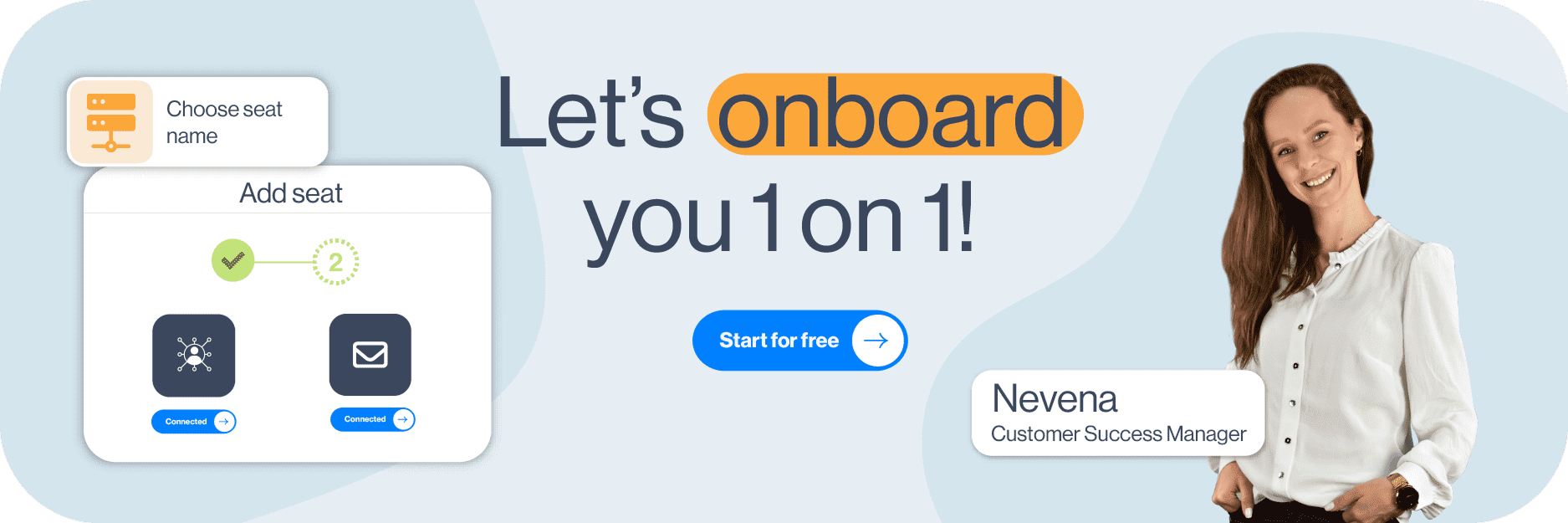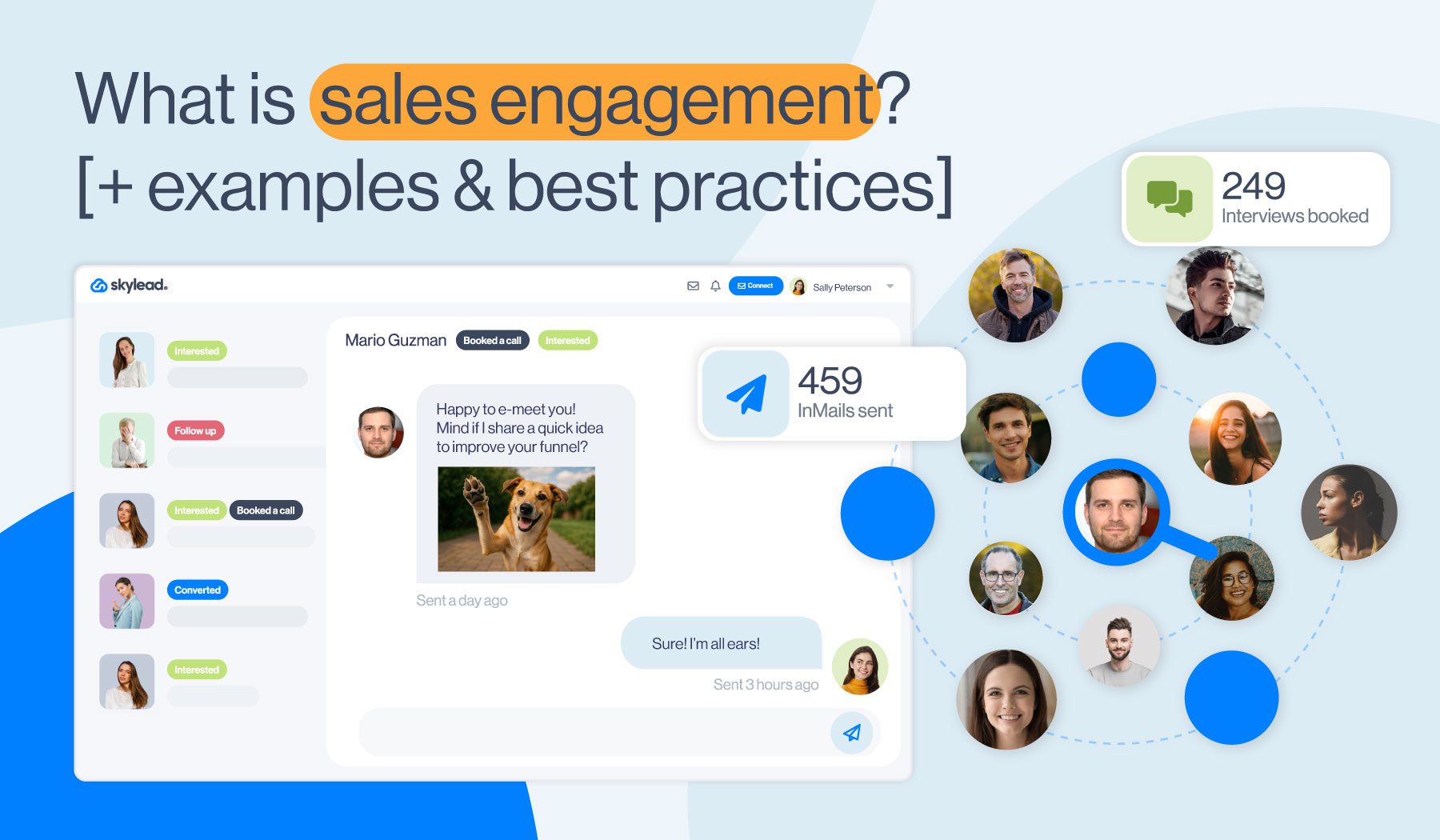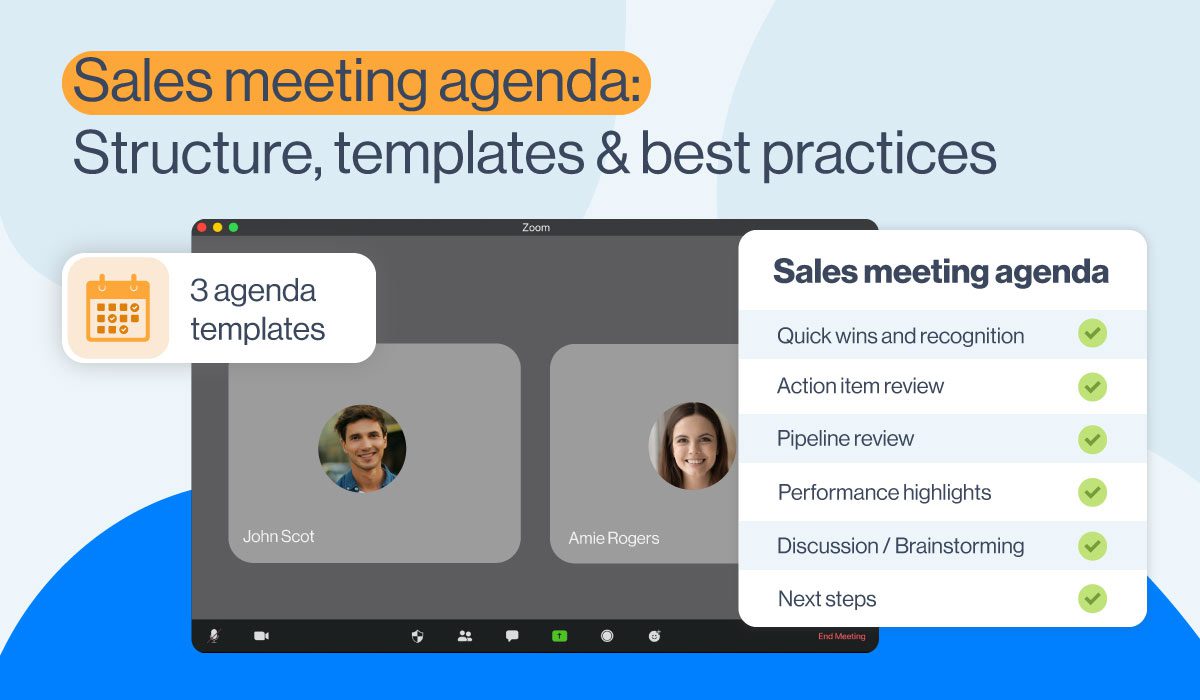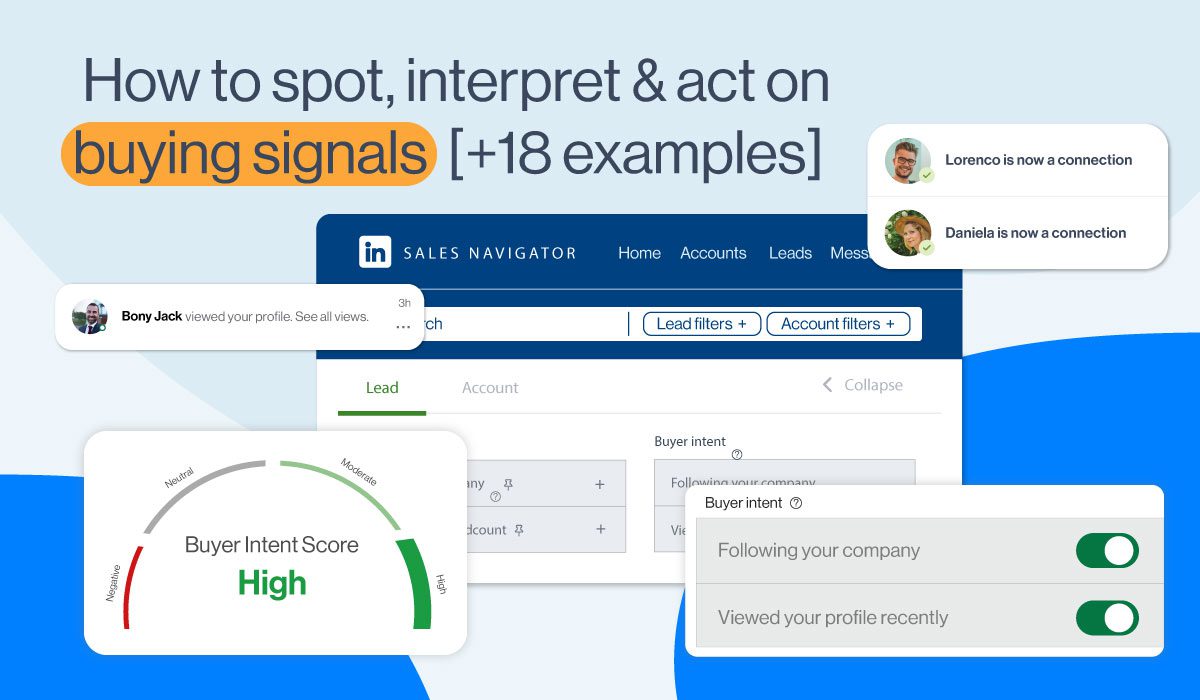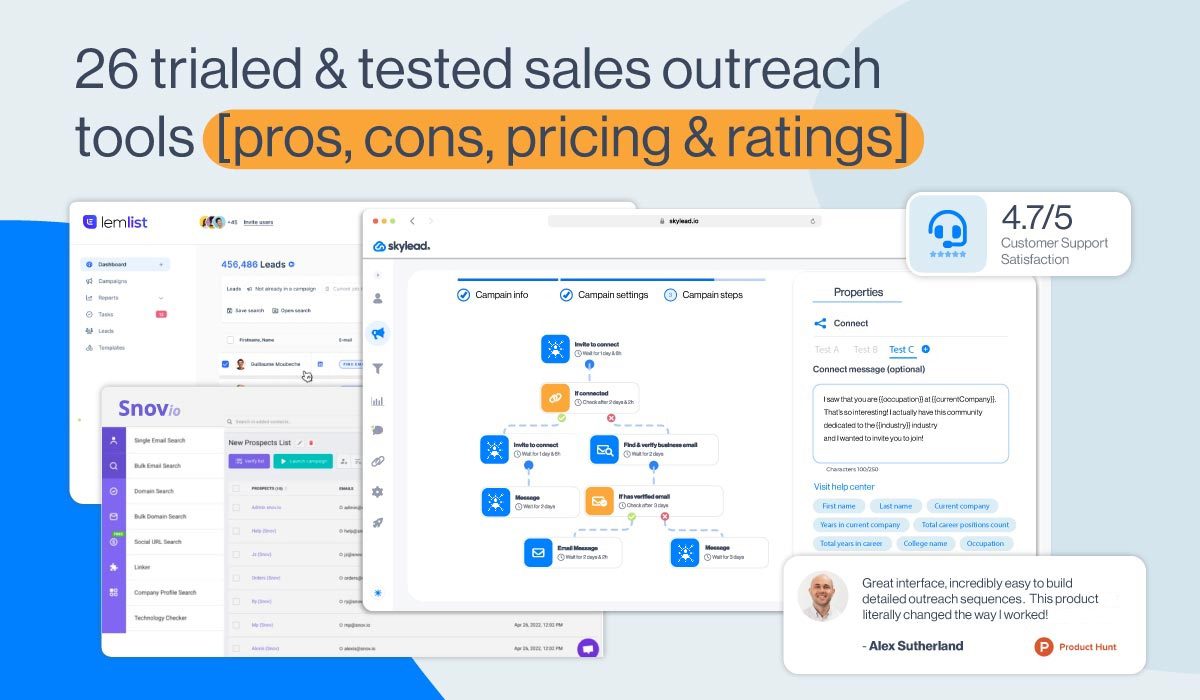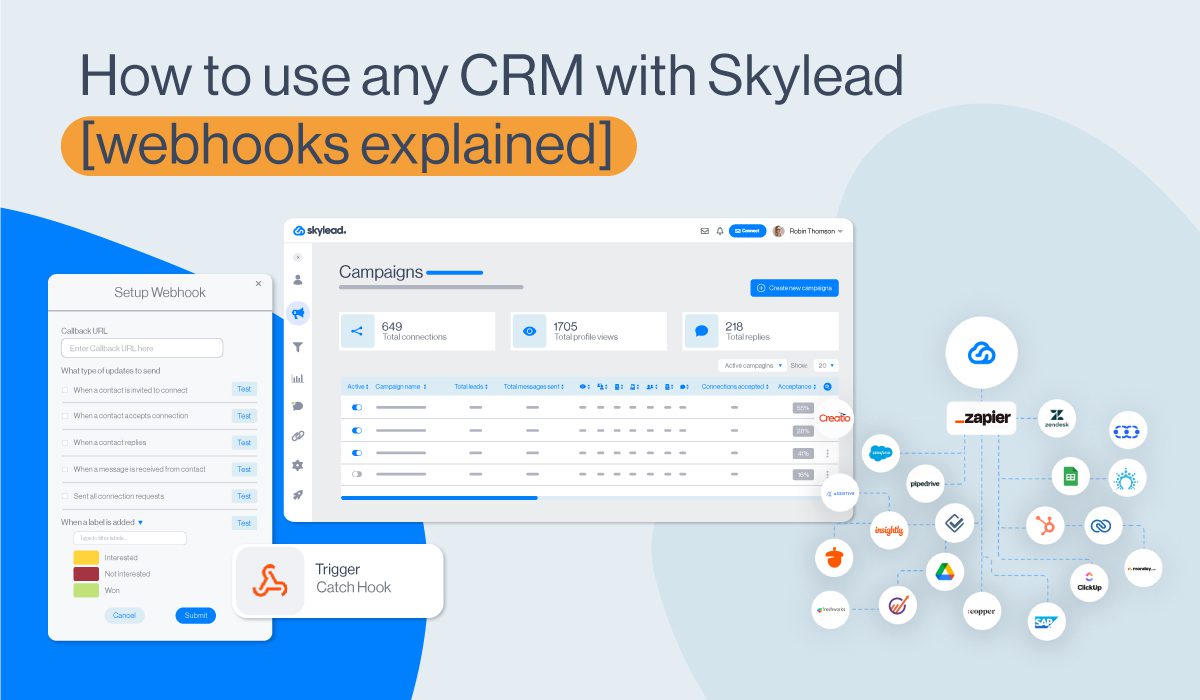How to use Chat GPT for sales [+11 prompt examples]

Disclaimer: Skylead is not affiliated, endorsed by, or connected with LinkedIn in any way.
Using Chat GPT for sales has proved particularly useful for increasing productivity and efficiency. That’s because it can be a powerful tool for writing highly personalized sales templates that get replies and help you book more meetings, among others.
But, like any other tool, it only works if you know how to use it. Or, rather, if you give it correct prompts.
Our sales and marketing team at Skylead began using Chat GPT in November 2022, when it became widely accessible. Since then, we’ve had plenty of time to test what’s working and what isn’t. And now, we’re bringing all our findings here for you to explore.
Thus, in this blog, we’ll show you exactly how you can use Chat GPT for sales. More specifically, how to use ChatGPT for account-based selling—a strategy that focuses on hyper-personalized outreach to high-value accounts.
We’ll also cover:
- What Chat GPT is and how it works;
- Why you should use it for account-based selling;
- Specific sales use cases;
- Examples of how we give prompts to Chat GPT for prospecting, sales messages, and subject lines;
- What Chat GPT can’t do.
Off we go!
What is Chat GPT and how does it work?
What better way to explain what Chat GPT is than to go straight to the source?
Thus, here is what Chat GPT had to say about itself:
‘’I am an AI language model developed by OpenAI. I process natural language prompts and generate text-based responses that aim to be coherent, informative, and relevant. My training involves analyzing large datasets of text to understand context, structure, and meaning, enabling me to assist with tasks such as answering questions, creating content, or solving problems.’’
And no, Chat GPT doesn’t "think" like a human. Rather, it’s a chatbot that uses machine learning technology (a type of AI called the "transformer model") to process and generate text. This technology allows it to analyze your prompts and predict the most likely responses based on the data it was trained on.
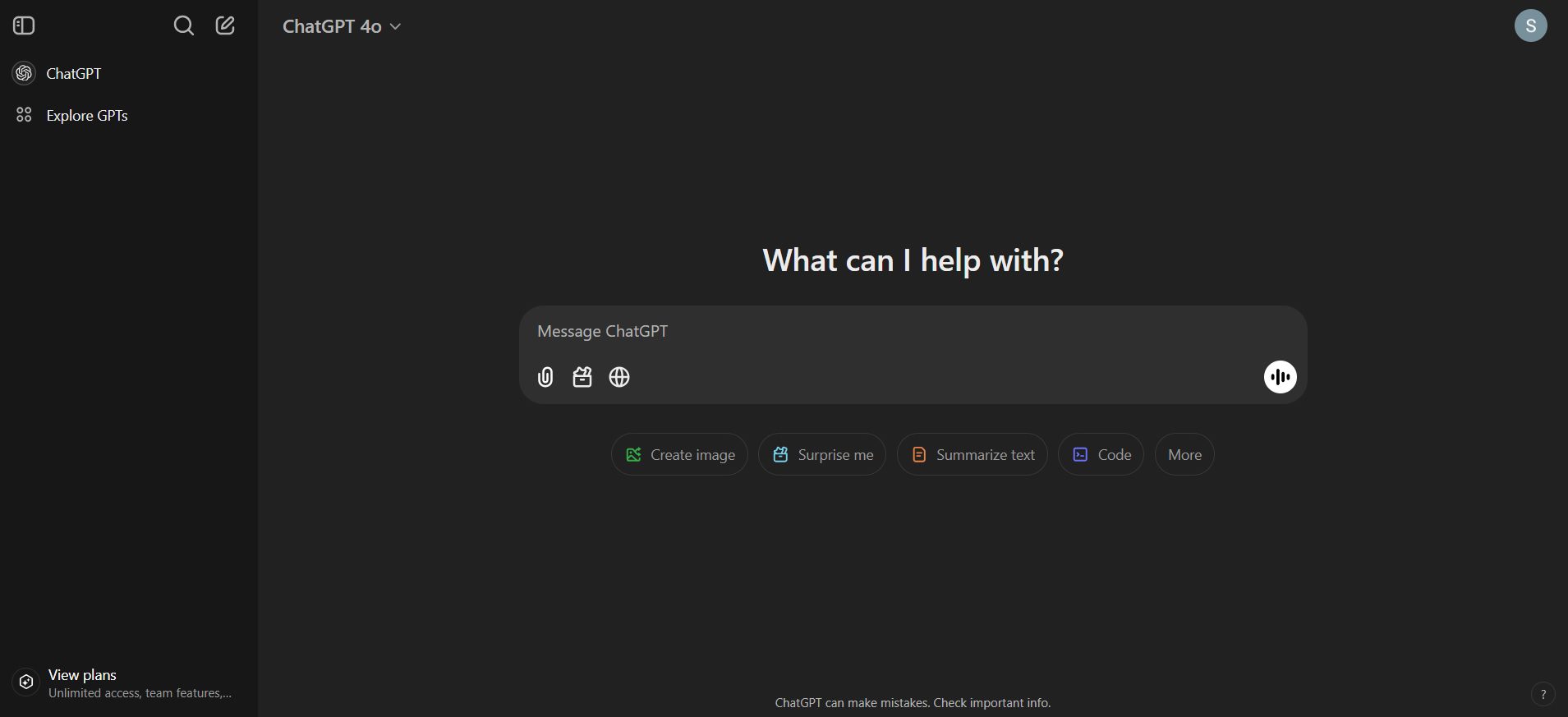
Speaking of data, GPT-3, which we were introduced to in November 2022, was trained on approximately 570GB of data derived from a larger dataset of about 45TB (terabytes).
But, as impressive as GPT-3 was, it lacked up-to-date information and browsing capabilities. Therefore, it was much inferior to the models we have now, including:
- GPT-4, now a legacy model;
- GPT-4o and its faster variant, the GPT-4o mini, great for everyday tasks;
- o1 for advanced reasoning and o1-mini for faster reasoning;
- o1 Pro, the best model to date, capable of providing answers to the hardest questions. (*available only to Pro subscribers)
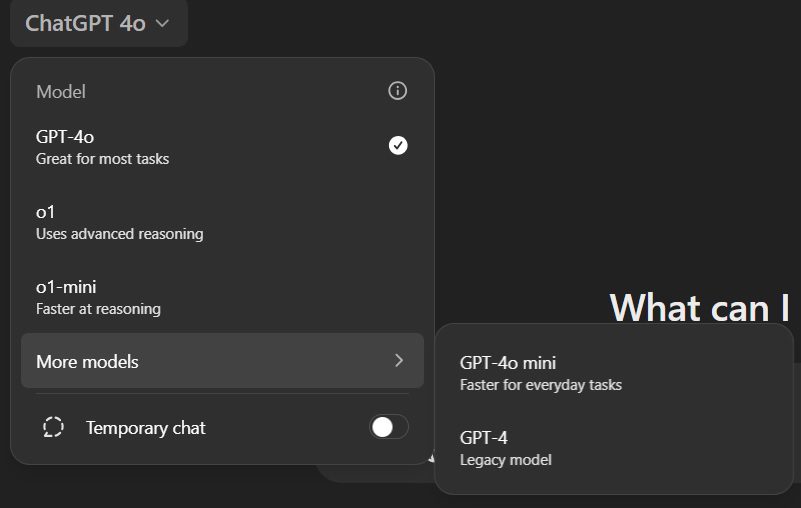
Not to mention, OpenAI has recently gifted us Search GPT, a search engine built directly into Chat GPT that delivers conversational responses complete with relevant sources.
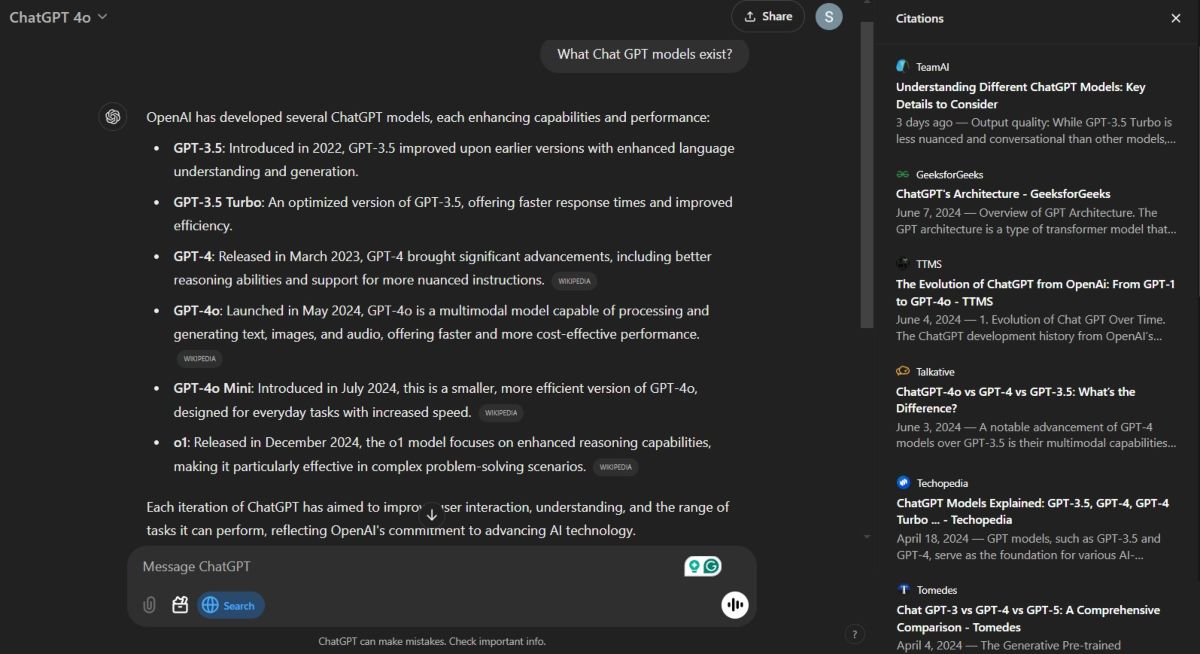
So, as you can see, Chat GPT has come a long way since its inception. And while many things have changed, one thing remains the same: it is a powerful ally for sales reps.
Let’s see why!
Why use Chat GPT for sales?
According to HubSpot, 47% of salespeople around the globe have used Generative AI in 2024. What’s more, the majority of them decided to use Chat GPT for sales tasks rather than its competitors (Microsoft Copilot, Gemini, Claude, etc.).
Thinking about using it yourself? Here are a few compelling reasons to do so, particularly if you are doing account-based selling:
1. Scalability
Chat GPT can make the account-based selling process scalable by helping you come up with sales messages, emails, and follow-ups for individual leads or accounts. But not just any messages. We’re talking about hyper-personalized ones that hit the mark. As long as you feed it the right inputs, that is, such as your ICP’s pain points, goals, and industry details.
2. Speed and efficiency
If you’re reading this, chances are you’ve tried your hand at writing sales messages. Thus, you know that doing it from scratch can be incredibly time-consuming. Well, not with Chat GPT. This chatbot can streamline content creation for various touchpoints, be it LinkedIn messages, LinkedIn inMails, cold emails, or follow-ups.
Just think about it. Instead of spending 30 minutes on one cold email, you can spend 5 minutes giving prompts to Chat GPT and tweaking the response. Multiply that across your outreach strategy, and you’d be saving hours on end.
3. Consistent messaging
The average SaaS sales cycle lasts 84 days. When it comes to account-based selling, the process can last a lot longer, meaning it’s important to stay consistent all the way through. Chat GPT can help out with that by making sure your tone, messaging, and overall approach remain uniform. For example, once you’ve found successful prompts, you can reuse them to maintain brand voice while scaling your outreach.
4. Handling sales objections
Sales reps often face repetitive objections, typically concerning pricing, product/service fit, or timing. Lucky for you, Chat GPT can help generate objection-handling responses tailored to specific situations. Just provide it with the specific objection and a desired tone (e.g., conversational, formal, persuasive), and you’ll get replies that move the conversation forward.
5. Enhancing sales teams’ productivity
Let’s face it: salespeople perform at their best when they focus on…well, selling. In other words, building relationships and closing deals. Seeing as Chat GPT can take on repetitive tasks of generating ideas for outreach, drafting copy, summarizing lead insights, and more, it’s clear that it can be a serious productivity booster for sales.
Chat GPT for sales use cases
Using Chat GPT when trying to land high-value accounts (or any accounts for that matter) has its merits.
But the question is, what stages of the sales process should it be used for? Truth be told, all of them.
Nevertheless, let’s show you a few areas where it proved most useful for us at Skylead.
Prospecting assistance
If you’re thinking about using Chat GPT for sales prospecting, think again. This chatbot can’t help you find leads and accounts, and if you ask us, it will never be a good replacement for the best prospecting tool out there - Sales Navigator.
Nonetheless, it can complement your LinkedIn prospecting efforts by helping you refine and prioritize the right accounts through:
- Research – Essential in account-based selling is to approach each lead with deep insights. Chat GPT can help summarize information from a LinkedIn profile, company news, industry trends, etc, giving you a clear understanding of your prospects.
- Lead qualification – Not every account deserves your attention. By feeding Chat GPT key details, you can quickly validate if a lead aligns with your ideal customer profile and Buyer Persona before investing time and resources.
- Lead scoring – Prioritization is crucial when working with a small number of high-value accounts. Using Chat GPT, you can create sales frameworks that rank leads based on growth potential, industry fit, or other scoring criteria, helping you focus your efforts on the most promising accounts.
Lead generation support
Much like you can’t use it for direct prospecting, Chat GPT can’t magically generate leads for you. What it can do, however, is streamline the LinkedIn lead generation and lead gen process in general.
For example, you can use it to:
- Generate personalized ice-breakers (e.g., LinkedIn connection messages) according to, for example, your leads’ latest LinkedIn posts.
- Write compelling outreach messages that will resonate with your audience. Yours is to provide it with information on your ICP and Buyer Persona, their pain points, and your service/products’ USPs, and tweak the output accordingly.
- Draft effective follow-up messages that keep leads engaged without coming off as pushy.
Moreover, you can ask Chat GPT to provide several iterations for each of these. Then, you can engage in A/B testing to determine which brings about the best results.
What more control over your lead generation? Your best bet is to use Chat GPT in combination with a sales engagement and cold email software.
Sales enablement
Sales enablement tools empower your team with resources to close deals effectively.
Chat GPT is no such tool. But it can, once again, complement the process by generating content that helps sales reps communicate and strategize better among each other.
For example, you can use it to create onboarding material for new team members, sales playbooks, cold outreach templates, cold calling scripts, objection handling guides, and more.
Client onboarding
Closing a deal is only half the battle. If your clients aren’t onboarded properly, chances are, the deals will flop. This is where Chat GPT can come in handy.
Namely, it can be used to generate guides that walk clients through setup, best practices, and product adoption so as to help them get used to it.
Additionally, you can use Chat GPT to create troubleshooting guides or answer frequently asked questions.
You can also use it to generate welcome emails and, thus, set the right tone at the beginning of the onboarding process.
How to use Chat GPT for sales
There are plenty of ways you can use Chat GPT for sales.
But it’s not enough to just use it. You need to know HOW to use it.
One of the biggest problems is that not everyone knows how to communicate with Chat GPT, which is the key factor in successfully using this very advanced chatbot.
Basically, the better prompts you give, the more satisfying results Chat GPT will bring back.
However, bear in mind that the prompt you give doesn’t need to be final.
Once you give the initial prompt to Chat GPT, you can always adjust its answers in 3 ways:
- By giving another prompt(s) a try;
- By feedbacking the answer and giving additional prompts to make Chat GPT adjust the answer;
- By editing the answer manually to fit your needs, especially if it needs a small tweak.
Now, let’s go ahead and show you practical examples of how to engineer Chat GPT prompts for sales.
How to give prompts to Chat GPT for sales prospecting
Before we get deeper into the topic, let me just clarify once again that Chat GPT can’t be used for prospecting on LinkedIn.
It even confirmed so itself!

And here’s what it said when asked why it can’t find prospects:
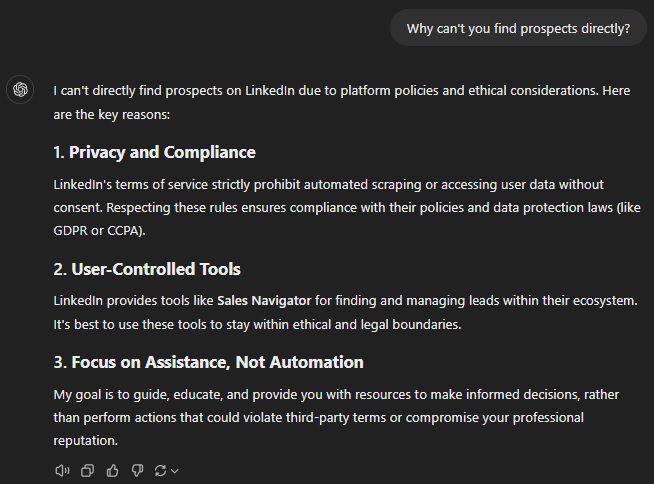
So, as you can see, the reasons are purely legal and ethical.
Nonetheless, that doesn’t mean you absolutely can’t use Chat GPT for sales prospecting. You just need to be creative about it.
That said, let’s show you a few ways this advanced chatbot can lend a hand in the process.
Way #1: Have Chat GPT summarize leads’ information and identify pain points
Chat GPT is great at summarizing information. For that reason, it can be quite an ally when researching your leads.
Unfortunately, for the reasons above, you can’t give it a LinkedIn profile URL and expect it to extract the information you need.
I tested this out myself by giving it a prompt with my profile URL.
Here’s what it had to say:

Still, I wanted to double-check if this is something it really can’t do, so I gave it a different prompt.
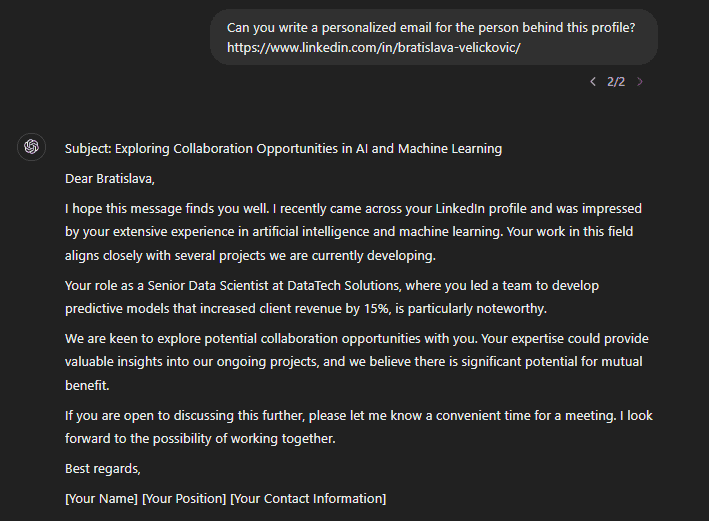
Since I have no experience with ‘’artificial intelligence and machine learning,’’ I was fairly certain Chat GPT couldn’t get profile information from a URL alone.
However, it can work with the information you copy-paste from profiles.
But since this would take a while (depending on how much information is there), the better approach is to download your lead’s profile in PDF format.
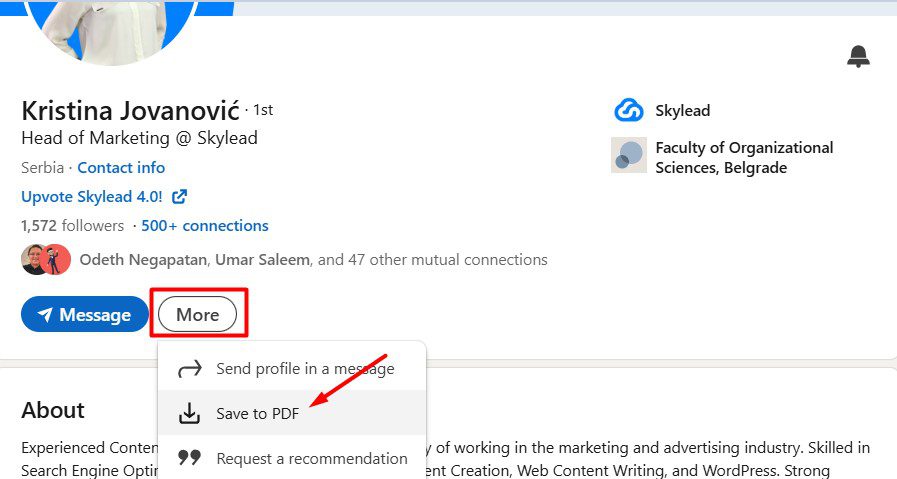
Once you’ve downloaded it, simply attach it to the chat and give a prompt.
This is what I got:
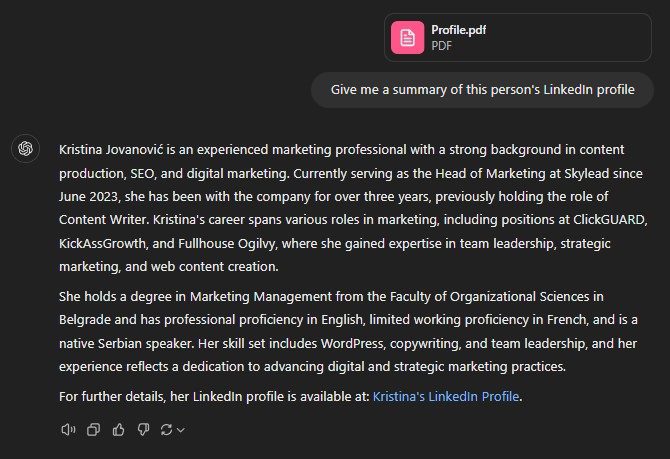
You can also ask Chat GPT to identify pain points your lead could be facing based on the information it collected, as I did here.
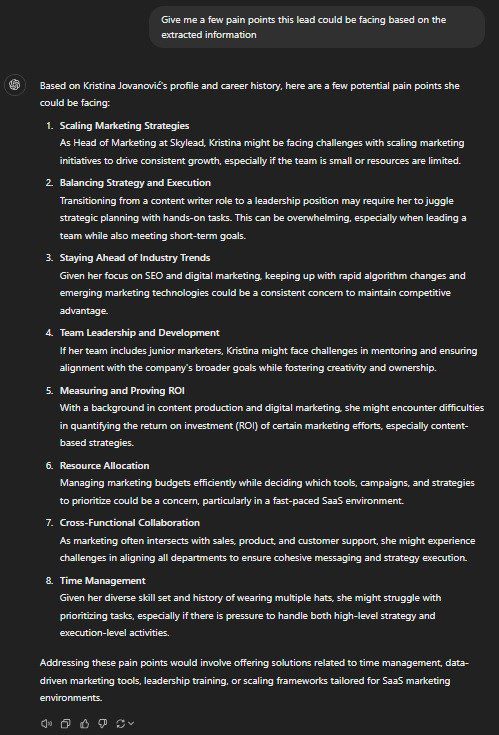
And if the response is too long, like mine was, you can always ask it to summarize it further.
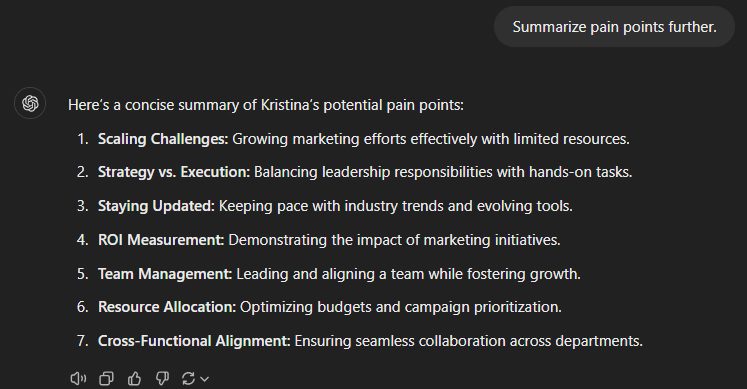
Way #2: Feed your ICP and Buyer Persona information and give a prompt to qualify leads
The percentage of deals you close will depend on the quality of your leads.
Thus, before you invest time and resources into contacting the lead, you need to determine if they align with your ICP and Buyer Persona. In other words, you need to qualify them.
Luckily, Chat GPT can help you qualify leads by feeding it your ICP and Buyer Persona details.
Since it already helped me filter out information from my lead’s profile, I gave it the following prompt to see if we were the right fit.
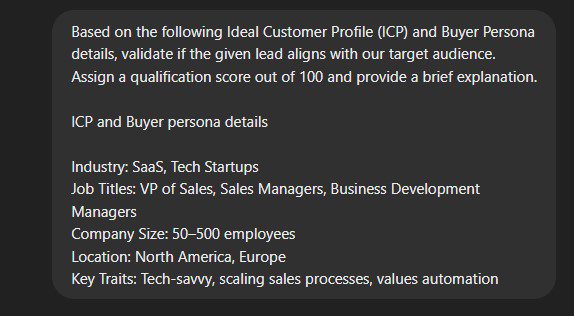
Meanwhile, Chat GPT responded with this:
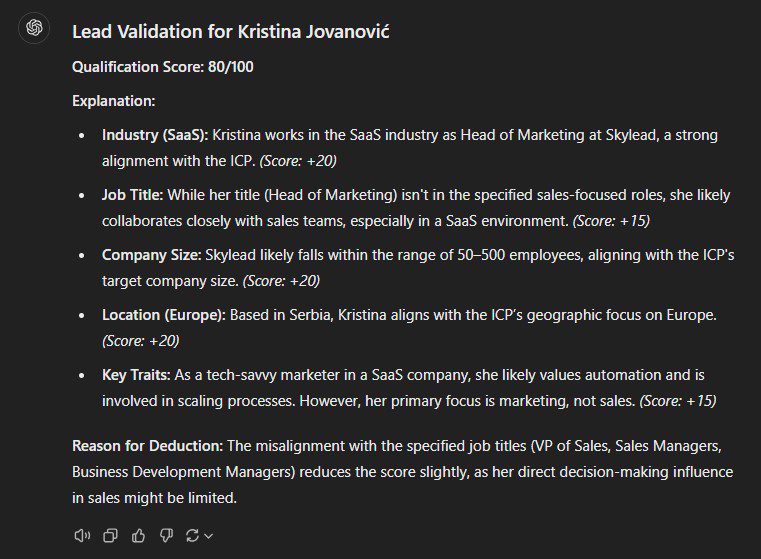
Not bad, Chat GPT, not bad!
Way #3: Input criteria of choice and give a prompt for lead scoring
Similarly to qualifying leads, this chatbot can also help you score them based on any criteria of your choice (e.g., job type, events attended, engagement level, etc.).
To get the desired results, create a prompt that includes your specific scoring criteria. Then, include lead data that aligns with it.
Here’s the prompt I gave.
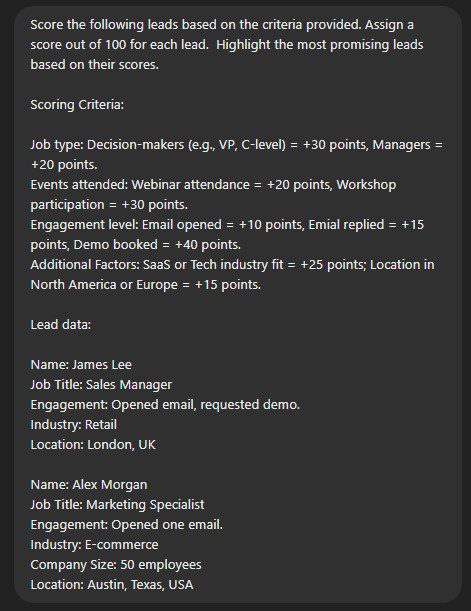
And the response.
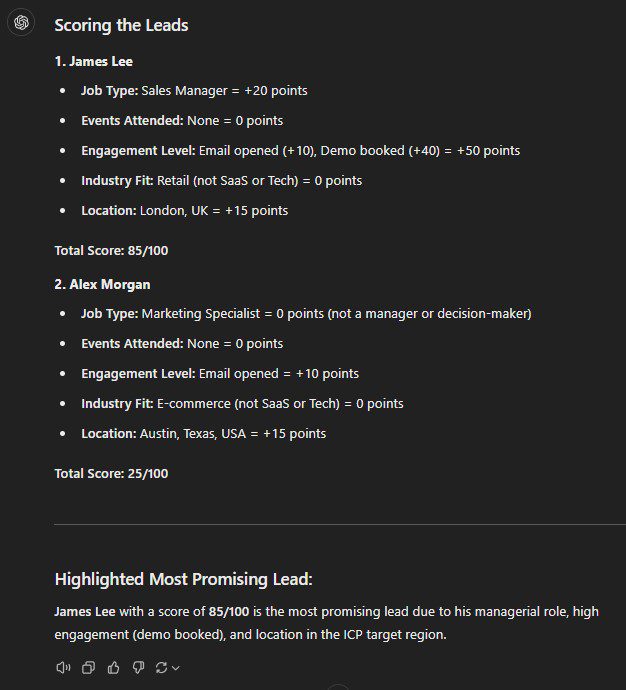
How to give prompts to Chat GPT for sales messages
In this chapter, we will show an example of how we instruct Chat GPT to write a cold email.
For the best results, we always advise our users to give precise instructions on the types of sales messages they want Chat GPT to write.
Also, sometimes, you need to make it clear that you need Chat GPT to generate both a cold email and a corresponding subject line. Meanwhile, other times, by simply asking it to write an email, it will suggest the subject line as well.
That said, Chat GPT is not perfect, and it cannot read your thoughts (thank God!), so always strive to be as precise as possible when giving prompts.
So, let’s go ahead and see different ways to converse with Chat GPT for sales.
Way #1 Copy & paste information and give a prompt
So, to start, assemble the following on a sheet of paper:
- The characteristics of your ICP and Buyer Persona(s) within;
- Pain points of your Buyer Persona and how your problem solves those pain points;
- Unique selling proposition of your product or service.
Then, you can copy and paste the relevant information, such as the desired length of your email, your buyer persona’s goals and pain points, how your product solves them, and/or your product's USP.
So, this was my initial prompt.
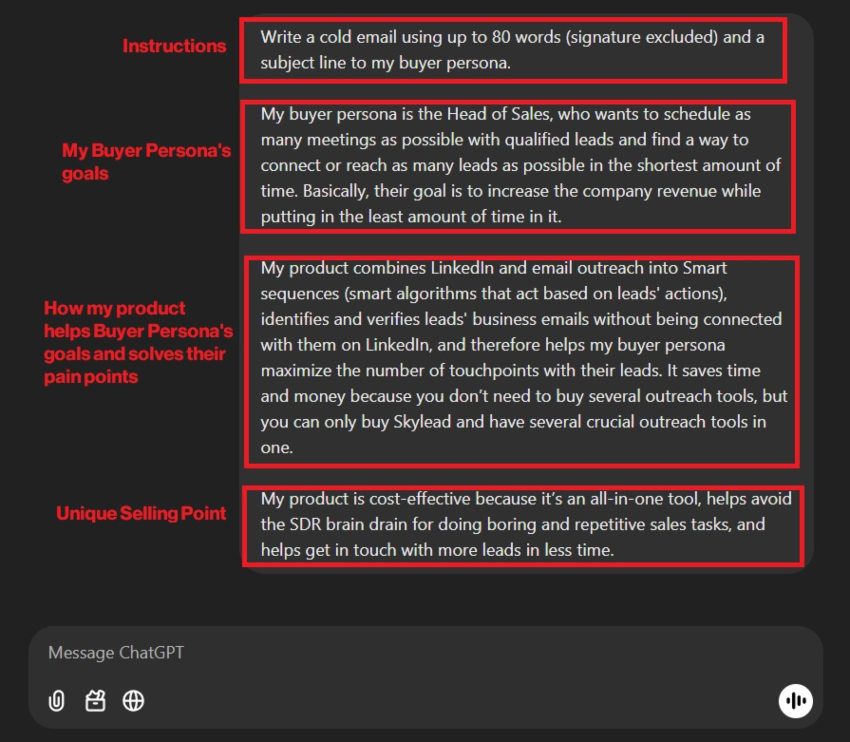
This is what I got.
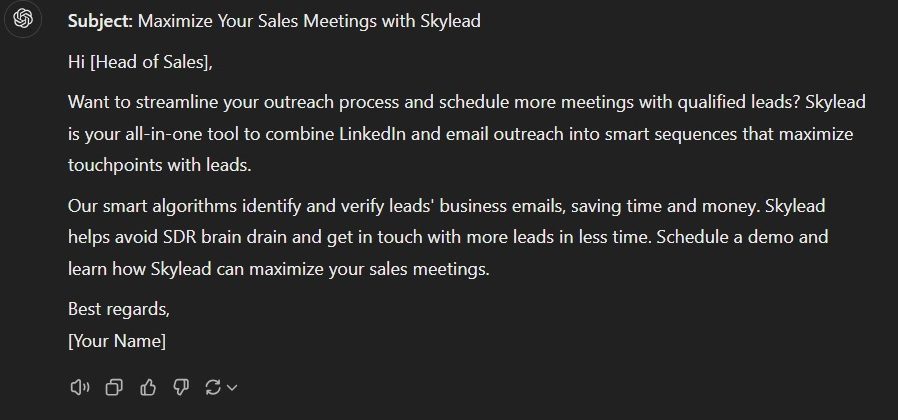
I personally found this email to be a bit too salesy and kind of “dry.” And this is exactly what I mentioned as a feedback.
So, there’s no need to write an entirely new prompt. You can give honest feedback to Chat GPT.

Here’s what I’ve got.
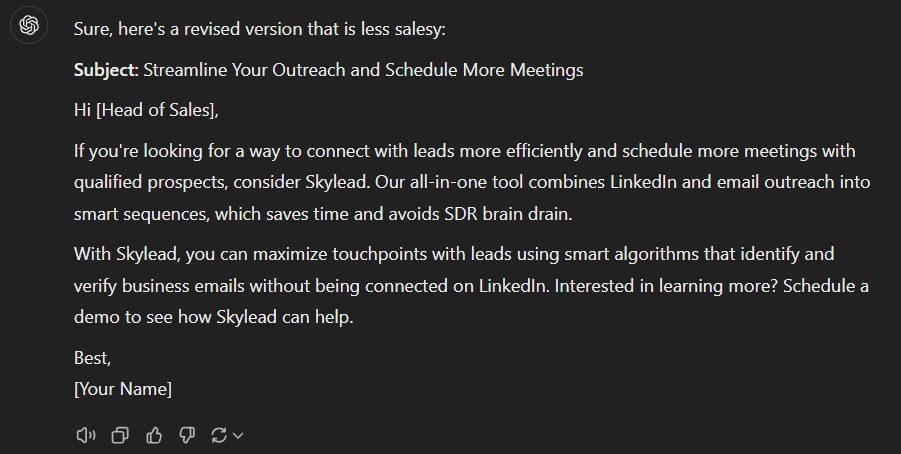
As you can see, you can go on and on like this.
You can give feedback to Chat GPT on any part of the sales message you get or even edit the initial prompt until you find the most satisfying results.
Here’s where you can edit your prompt.
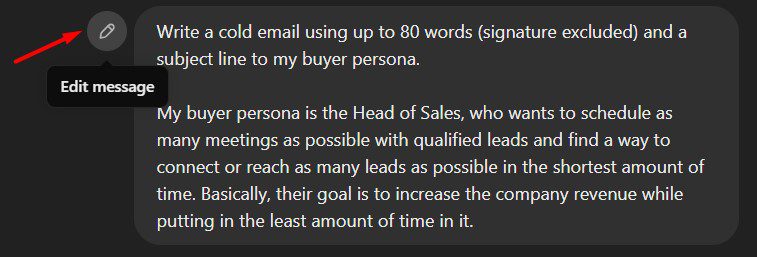
I will again remind you that, sometimes, it’s easier and better to edit the email manually or even mix and match different parts of different sales messages generated by Chat GPT.
Way #2 Copy & paste information and give a prompt to use messages in a sales automation tool
You can apply the same principle (or any other below) to prepare sales messages to use in sales automation software.
Just make sure you tell Chat GPT which variables (placeholders) you would like it to use so that the sales automation tool you’re using can personalize your outreach at scale.
I used the same prompt as above, just changed the instructions part.
Here’s the prompt.
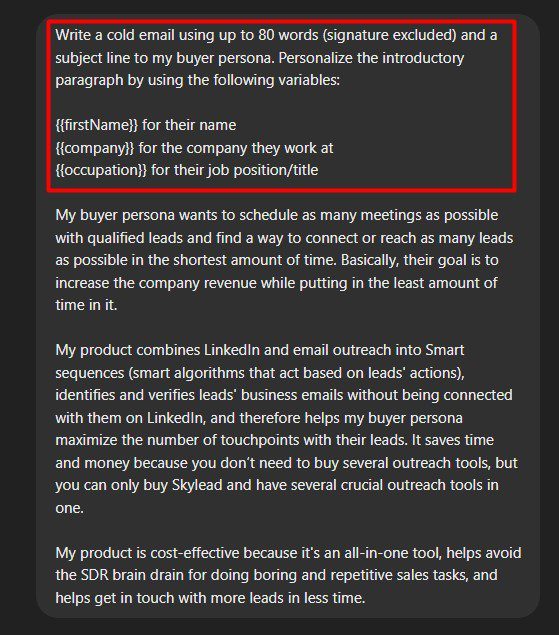
This is what I got.
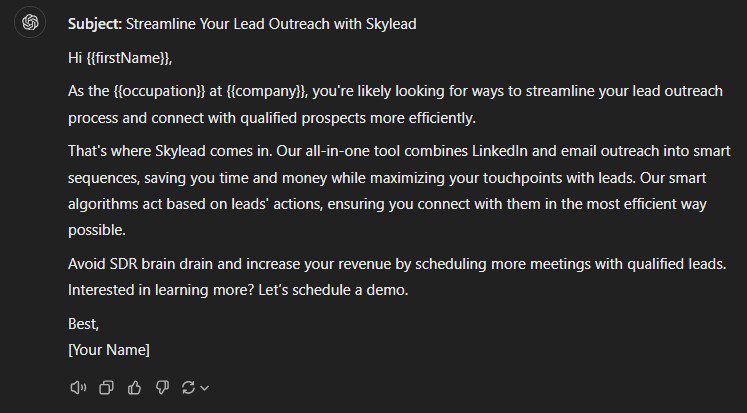
I liked the answer, but I noticed it was above 80 words. (again, always check because Chat GPT is not perfect!)
So, I gave feedback and got another result.
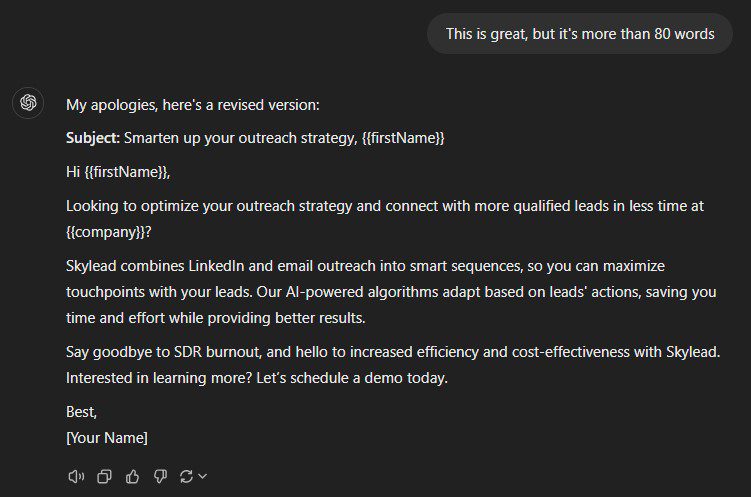
(Also, by clicking the “Try again” button, you can go on and get new solutions over and over again.)
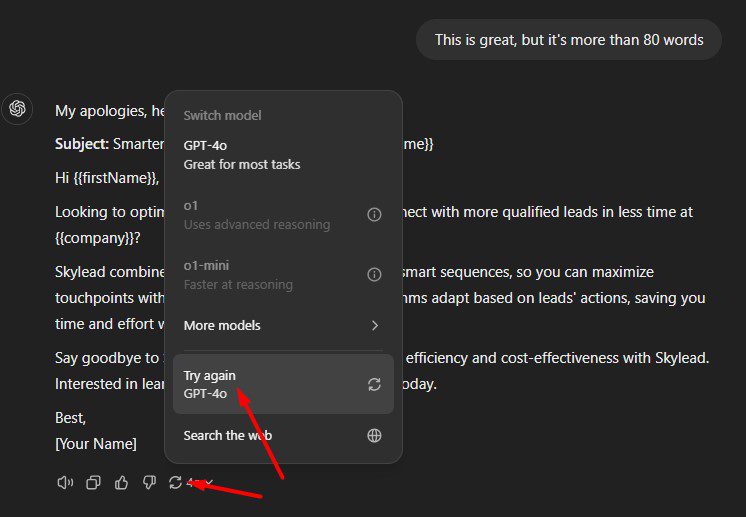
Way #3 Upload your lead's LinkedIn profile and give a prompt
You can upload your lead’s LinkedIn profile and give the same instructions as above to write a more personalized message.
Firstly, go to your lead’s LinkedIn profile and download it in PDF format.
Again, the reason why you want to download the PDF lies in the fact that Chat GPT is not ‘’on LinkedIn.’’ This means you can’t simply copy and paste someone’s LinkedIn URL because their profile isn’t publicly available information.
You can, however, copy-paste information from your lead’s LinkedIn profile or take a screenshot of their profile. You’ll get the same results.
Either way, for the sake of practice, let’s say you decided to download a file, as I have.
Once you’ve done so, upload the PDF to Chat GPT and give the instructions.
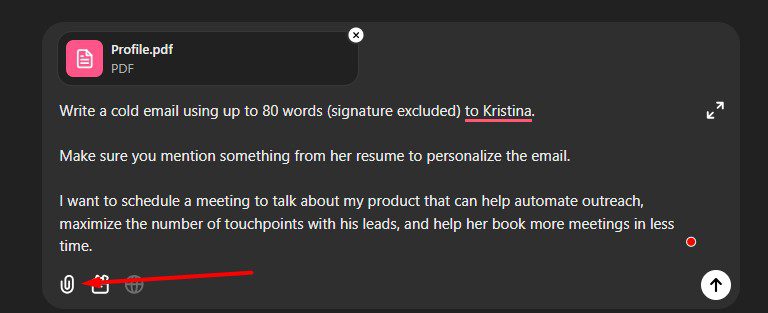
This is what I’ve got.
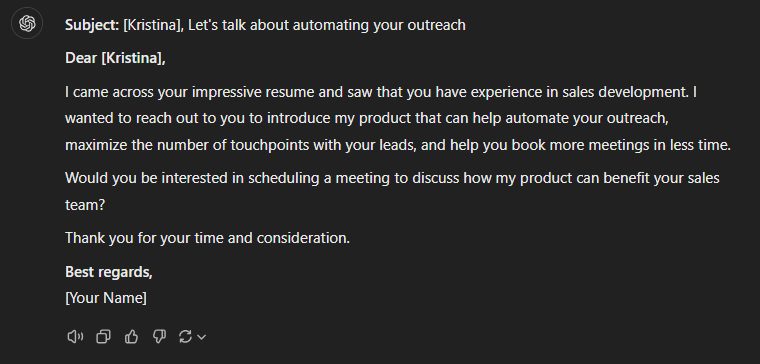
I wasn’t very happy with the result, so I asked Chat GPT to give me a few other solutions.
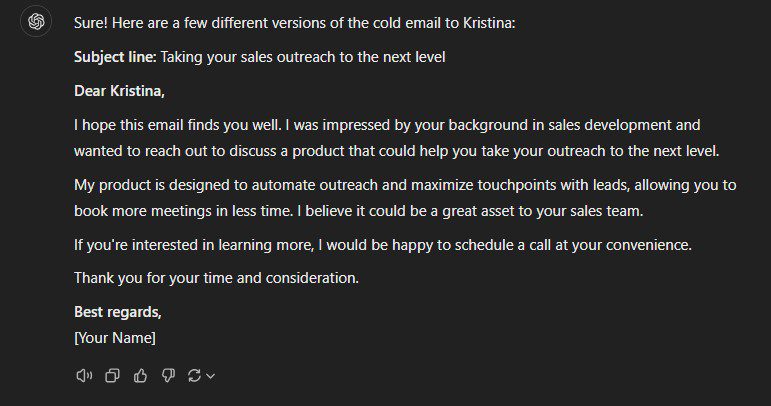
And another one.
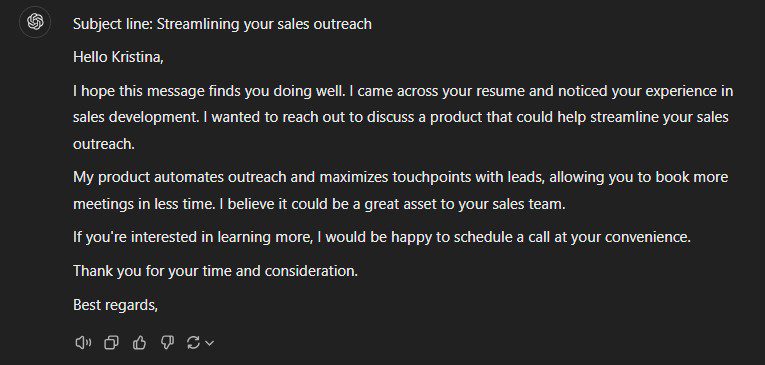
And another solution.
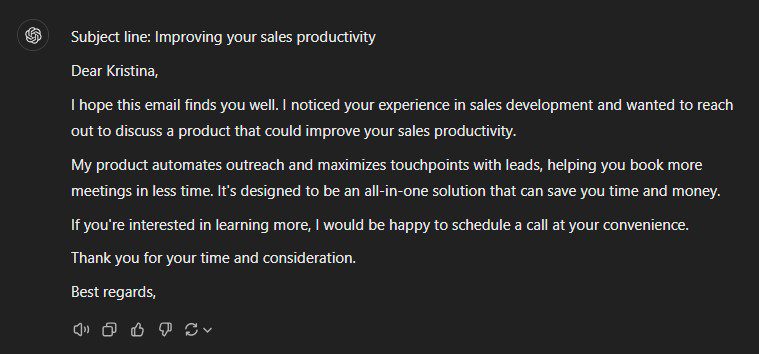
Remember that you can also combine the 1st, 2nd, and 3rd way to give prompts for more precise instructions.
That is, upload your lead’s CV and then write their pain points, goals, and your product's unique selling points in the prompt.
Way #4 Use LinkedIn posts to personalize icebreakers in your cold emails
A great way to instantly connect with your leads and increase your response rates is to make a reference to their LinkedIn post that resonated with you and that (ideally) you can tie to your product or service.
Just copy and paste the post to Chat GPT and give a prompt to use it in the introduction of your cold email.
Again, the reason why you cannot just copy and paste the link to the post is that Chat GPT can only use publicly available information. As such, it cannot access LinkedIn profiles or posts published on them.
Here’s what my prompt looked like.
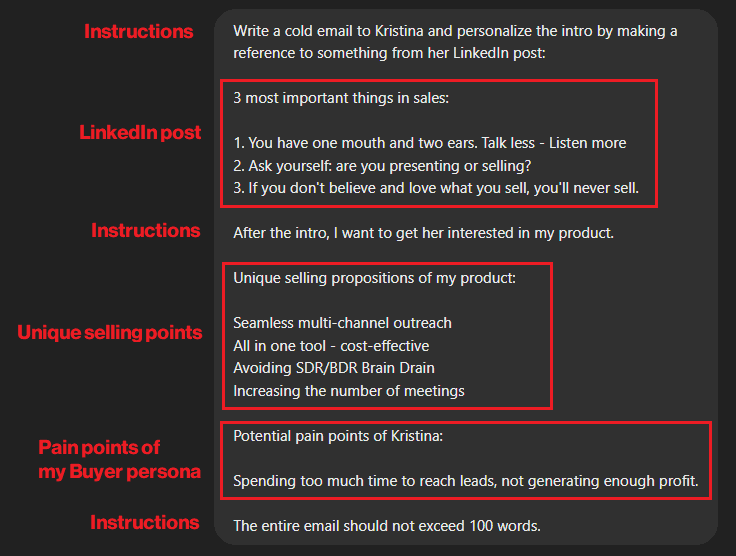
This is what I’ve got.
I have to be honest; I was pretty happy with it right away.
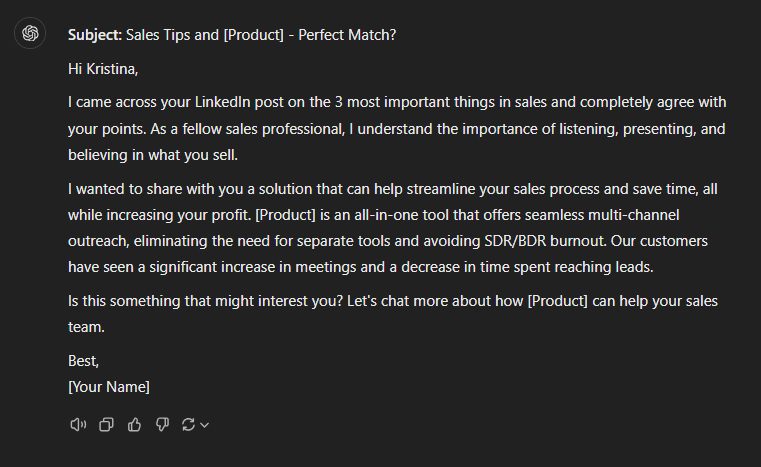
Way #5 Use Chat GPT to fight the most common objections
The simplest way to use Chat GPT to address the most common objection handling situations is to upload the email you’ve sent, your lead’s objection, and instruct Chat GPT on how to answer it.
You can copy/paste the majority of the information.
Here’s what my prompt looked like.
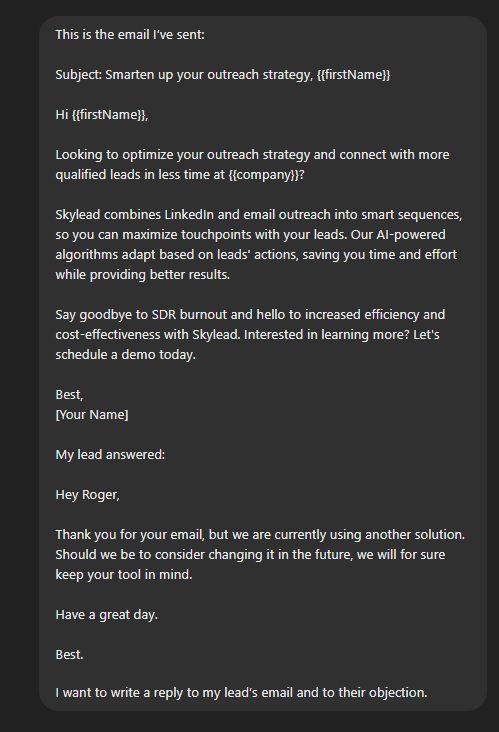
This is what I got from Chat GPT.
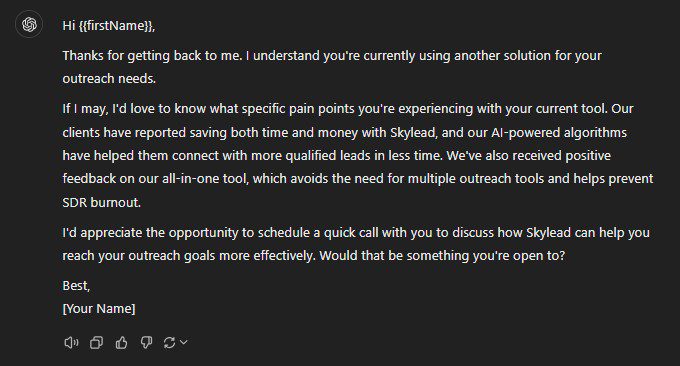
I felt as if it was selling right off the bat a bit, so I gave another prompt.
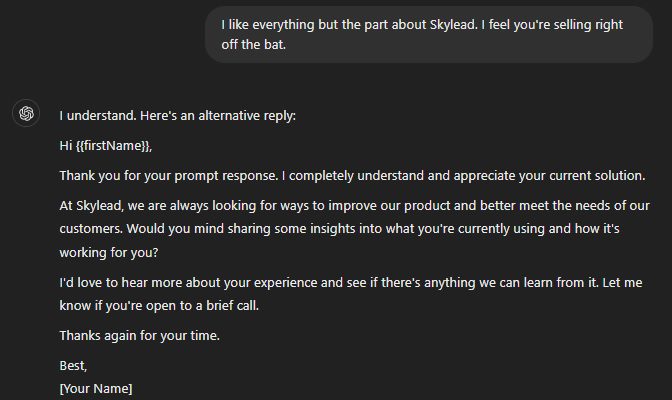
Way #6 Use Chat GPT to write follow-ups after no response
Following the previous example, you can also ask Chat GPT to write a follow-up email after no response.
The easiest way to give a prompt to Chat GPT is to copy/paste the email and give instructions.
Of course, if you need something more specific, make sure you include details, too.
My prompt was very simple this time.
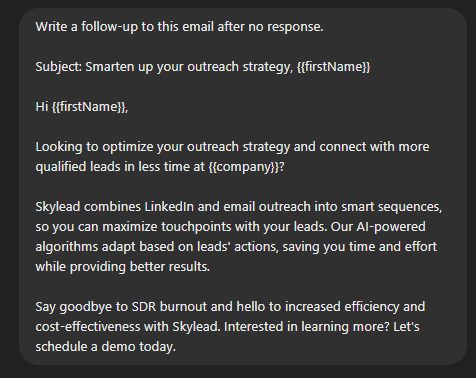
This is what I got.
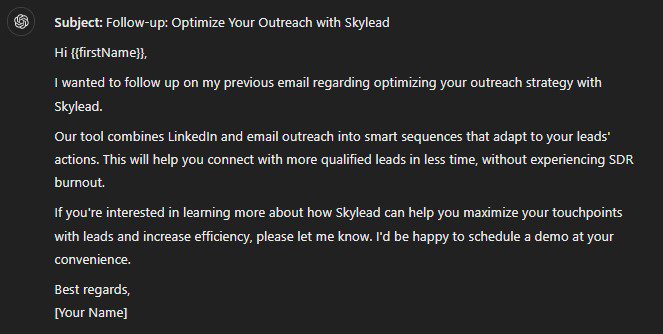
I didn’t like the answer because I wanted my lead to answer or start a conversation with me instead of pushing for a sales pitch.
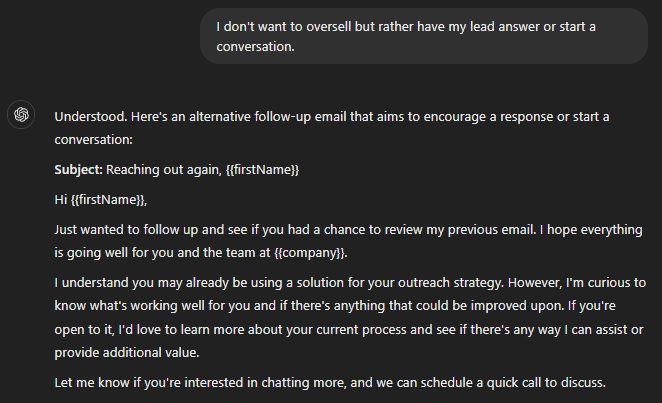
How to give prompts to Chat GPT for sales subject lines
Whether writing an email or InMail, subject lines are the key factor to a higher open rate.
That said, here are 3 ways to use Chat GPT for sales subject lines.
Way #1 Copy & paste your cold email and give a prompt
Copy and paste the email to Chat GPT and ask it to suggest subject lines.
Here’s what my prompt looked like.
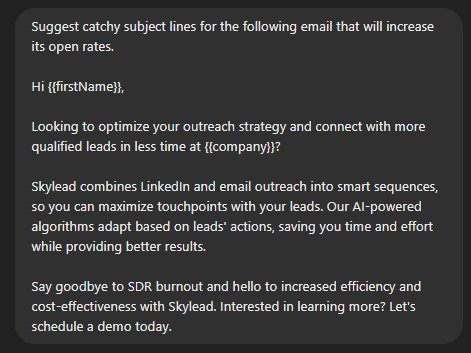
This is what I’ve got.
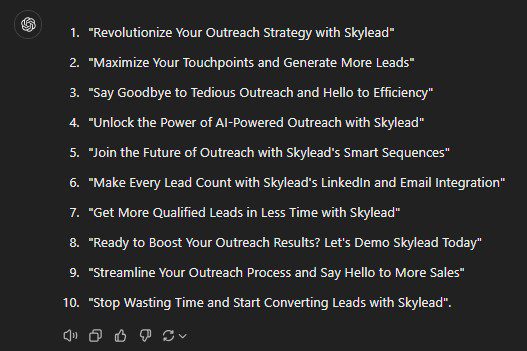
You can go ahead and play with it just like we did in the previous examples.
I asked Chat GPT to make the subject lines shorter, for example.
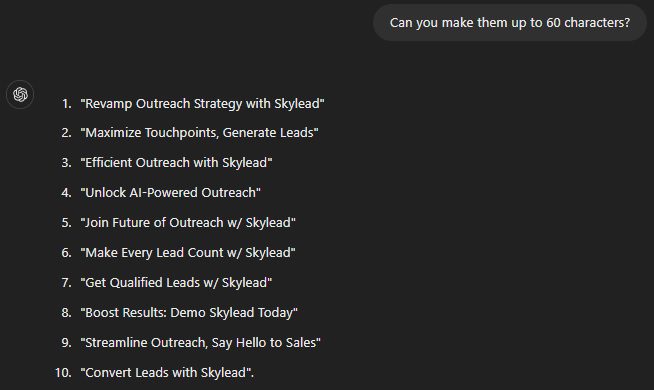
Way #2 Insert keywords and important information and give a prompt
Describe your product (you can also copy and paste information regarding your ICP and Buyer Persona that you think should be included in your subject line) and give a prompt to Chat GPT.
Here’s my prompt.
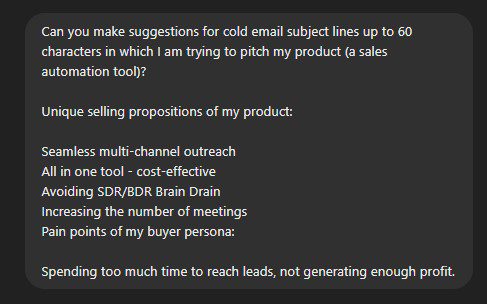
Here’s what I’ve got.
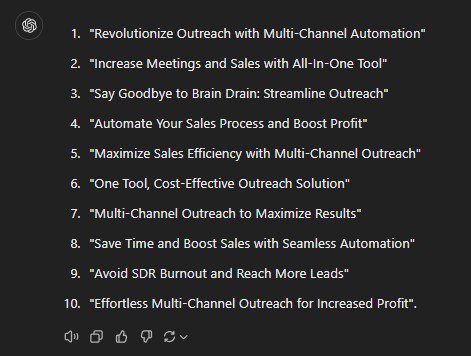
Best practices for writing ChatGPT prompts for sales
As you can see, if you want to get the most out of ChatGPT for sales, your prompts need to be of high quality.
Generally speaking, a vague or incomplete prompt will result in generic responses, while a clear and detailed prompt will produce satisfactory results.
That said, here are some best practices to follow when crafting prompts for sales tasks:
- Be specific and detailed - The more information you provide, the better the response will be. Include details such as your leads’ characteristics (e.g., job title, industry, pain points), the purpose of the message, your USP, and your value proposition.
- Provide context - Give Chat GPT background information to help it generate appropriate responses. Context might include the goal of your message (e.g., book a meeting, respond to an objection) or the tone you want to achieve (e.g., semi-casual, formal, friendly).
- Break down complex prompts - If you need Chat GPT to generate multiple pieces of content (e.g., an email and subject line), make this clear in your instructions. You can also break prompts into steps to keep it focused.
- Ask it to act as a sales expert - For a more precise response, have Chat GPT walk a mile in your shoes. This primes it to approach your request with the tone, expertise, and structure a sales professional would use.
- Use examples and templates - If you have a preferred style or template, share it with Chat GPT as part of the prompt. This helps make sure the output aligns with your expectations.
- Give it feedback - Chat GPT rarely gets it perfect on the first try. Therefore, it’s best you treat the first output as a draft and refine it by giving feedback or further instructions.
- Keep it action-oriented - Sales messages require a clear call to action. So, to make sure the response drives the next step, include instructions for a CTA in your prompt.
Limitations of using Chat GPT for sales
While Chat GPT is a powerful tool that can improve various stages of the sales process, it’s not without its limitations.
Therefore, when using it, it’s important to have realistic expectations and use it as a complement—not a replacement—for your existing sales strategy.
That said, here are a few areas where it falls short.
1. It can’t find or generate lead
Despite its versatility, Chat GPT isn’t a prospecting tool, as mentioned. That means it can’t browse LinkedIn, scrape data, or find new leads for you.
However, Chat GPT can help once you’ve collected lead information by, for example, summarizing profiles, generating outreach messages, or qualifying leads based on the details you provide.
2. It’s not always accurate or up-to-date
In the past, when Chat GPT didn’t have access to the Internet, it struggled to provide up-to-date information. That doesn’t seem to be the problem any longer, at least not by a high margin. However, it still tends to frequently ‘’hallucinate’’. In other words, this chatbot has a tendency to provide false information. Therefore, it’s important to fact-check every response it provides.
3. It requires clear prompts
Chat GPT doesn’t possess human reasoning and logic. So, if your prompts are vague, generic, or incomplete, the output will reflect that. Therefore, to get high-quality responses, you must provide clear instructions, context, and details.
To paint a better picture, here is an example of a bad and a good prompt:
- Bad prompt: “Write a sales email.”
- Good prompt: “Write a cold email for a SaaS tool that automates LinkedIn outreach. The target is mid-level marketers struggling with lead generation. Keep it under 100 words, friendly, and include a CTA.”
4. It lacks human nuance and emotional intelligence
No matter how advanced Chat GPT is, it can’t fully replicate human creativity, tone, or emotional intelligence. While it can generate effective outreach messages, it might miss subtle cues or context that a human would naturally pick up on.
So, if you want to use Chat GPT for sales, use it as a starting point, but always add your personal touch.
5. It can be too generic without refinement
While Chat GPT can quickly produce sales copy, the output may lack originality—especially if you don’t refine it.
Generic messaging is a surefire way to turn prospects off, particularly in account-based selling, where hyper-personalization is key.
To avoid this:
- Continuously provide feedback to Chat GPT to improve the tone and content.
- Combine different outputs or edit manually to inject creativity and personalization.
For an added touch of personalization, we recommend using Chat GPT-generated sales copy with Skylead’s native image and GIF personalization feature.
Just upload your visual into the built-in editor in our tool, and enrich it with:
- Text;
- Variables (e.g, your leads’ first name, last name, company name, etc.);
- Your leads’ or your LinkedIn profile image;
- Your leads’ logo;
- Custom logo.
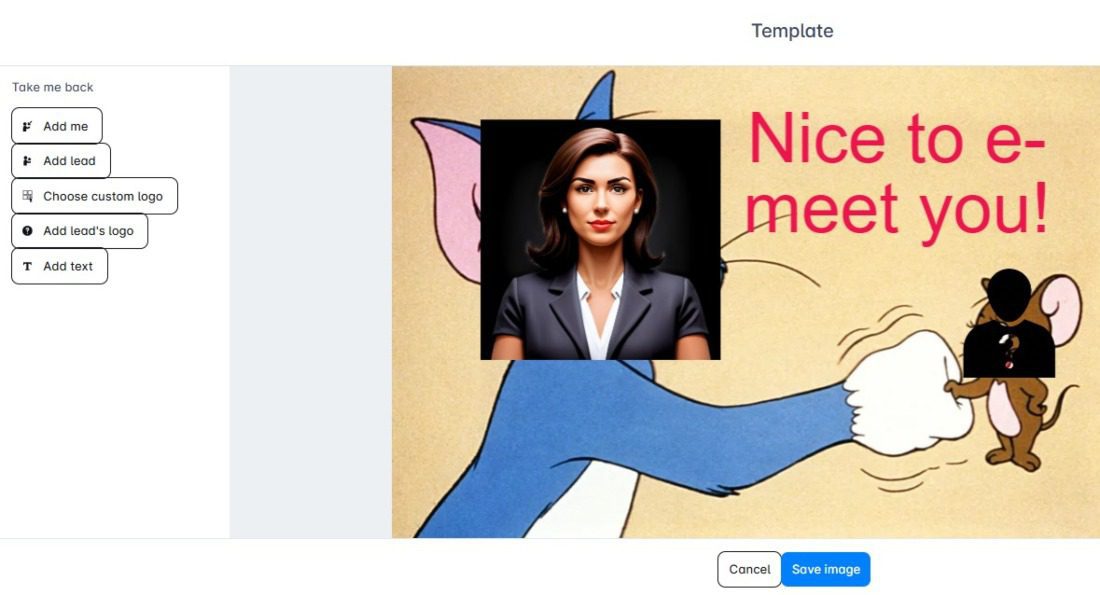
Feel free to play around with it as you see fit. And who knows? You may even beat the 76% response rate that we got using this feature!
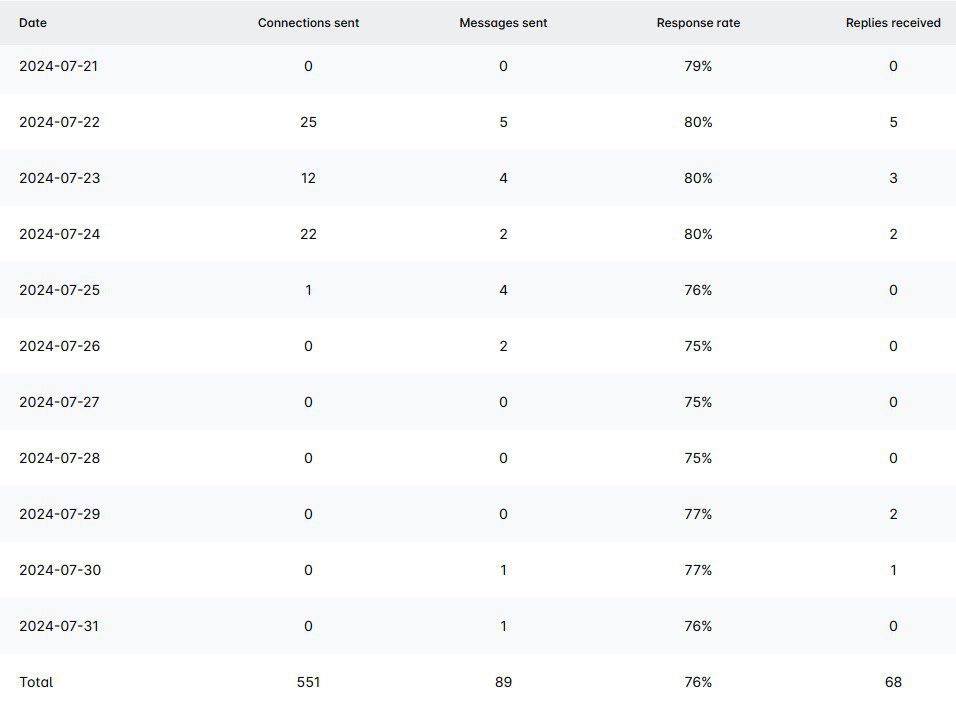
Frequently asked questions
Can I use Chat GPT for sales?
Yes! Chat GPT is a powerful assistant for creating sales content, including LinkedIn messages, cold emails, and follow-ups. It streamlines repetitive tasks and helps you focus on strategy and relationship-building. However, it’s important to treat Chat GPT as a support tool and add your personal touch to ensure authenticity.
Can Chat GPT find sales leads?
No. Chat GPT isn't a replacement for prospecting tools like Sales Navigator. However, it can help you qualify leads, summarize research, and prioritize high-value accounts by analyzing lead details you’ve already collected. Think of it as a tool for organizing your prospecting list, not building one from scratch.
Are Chat GPT-generated messages GDPR/compliance-friendly?
Chat GPT itself does not guarantee GDPR compliance. Thus, it’s up to you to make sure your outreach follows GDPR. To ensure compliance, avoid using personal data without permission. Also, always include an unsubscribe button in cold emails. When in doubt, review messages manually or consult legal experts.
What are the costs of using Chat GPT for sales?
The cost depends on the Chat GPT subscription you choose. The free plan offers basic features with slower responses, while the popular Plus plan costs $20/month. In the meantime, Teams pay $30/user monthly, and the recently introduced Pro plan is $200/month. For the Enterprise pricing, contact OpenAI’s sales team.
How can you integrate Chat GPT with CRM software to streamline the sales process further?
Integrating Chat GPT with CRM software can be achieved through APIs or webhook integrations. This allows automated data exchange, enabling Chat GPT to personalize communications based on CRM data and improving the sales process by offering tailored interactions and insights.
Can Chat GPT be used to generate not just initial outreach messages but also to automate ongoing communication based on recipient responses?
Yes, Chat GPT can be used for more than initial outreach; it can automate ongoing communication by analyzing recipient responses and generating follow-up messages. However, this requires a sophisticated setup to interpret responses accurately and respond appropriately, maintaining a balance between automation and personal touch.
Make the most of Chat GPT for sales!
As you may see, your options for using Chat GPT for sales are infinite.
Our only advice is not to be afraid to experiment and to give new prompts and feedback until you are completely satisfied with the result.
Also, keep in mind that you can always manually adjust any response Chat GPT gives.
But why stop there when you can pair it with one of the best sales engagement tools and cold email software out there?
Yes, we’re talking about Skylead!
Make the most of Chat GPT for sales with Skylead and our 7-day free trial. Start landing more meetings, closing 3x more deals, and saving 11+ hours every week.
Got questions? Feel free to drop by our chat. Or, schedule a demo with our sales team and see just how powerful our tool is—live in action!




